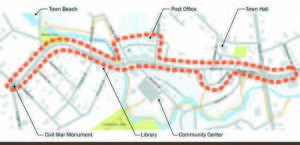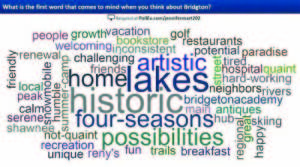Streetscape design kickoff meeting — Turnout shows love of Main Street

THE PROJECT AREA for Bridgton’s Main Street Streetscape redesign runs from Main Hill at the Civil War Monument to Mechanic Street at lower Main Street, just past Food City. It also includes two areas of potential future development — Park Street and Depot Street.
By Gail Geraghty
Staff Writer
Over 40 residents gathered at the Bridgton Community Center last week to ensure the best future for the town’s heart and soul — downtown Main Street.
Eloquent words by Town Manager Bob Peabody kicked off the meeting, as the audience learned they were in good hands: Peabody grew up in a downtown merchant family that ran a clothing store, so he understands the passion Bridgtonites have for their unique downtown. He also led a similar streetscape redesign when he was town manager in Rockport.
“What you have to do, is to make your downtown an experience,†Peabody said. “And part of the way to do that is to make your downtown visually interesting.â€
With Route 302 being the second-highest traveled highway in Maine, and Bridgton’s Main Street commercial district halfway between Portland and North Conway, N.H., “We’re in a great spot,†Peabody said. “It doesn’t get any better than that. We already have the bones on our Main Street for making it vibrant, fun and economically viable. Having done this before, it’s my experience that if we take this project on in earnest, we will experience that economic vitality.â€
Jeff Hyland, owner of Ironwood Design Group, explained the importance of public participation in the early stages of creating a streetscape design, which the town has hired him to do. “It’s about creating a clear identity†and then expressing it visually (through curb appeal, lighting, crosswalks and such), so that it reflects your values and identity,†he said.

WHAT’S THE FIRST WORD that comes to mind when you think of Bridgton? Here are some of the answers given at last week’s Streetscape Design kickoff meeting, with larger type indicating multiple responses. Planners say feedback from residents will be critical to the success of the design, and have set a number of ways for the public to give their input.
“Bridgton is an amazing community because you have so much going on, in a relatively small footprint,†Hyland said. “I can’t think of a community that has both a large wild area (Pondicherry Park) and then just a short walk to the beach. It’s really an unusual community.â€
With him was landscape architect Jen Martel, who got people talking and laughing by asking a simple question: how long have you lived or worked in Bridgton. Nine people said 20 years or more, 12 people said 10 to 20 years, seven said five to 10 years and 12 were “newcomers†of five years or less. All of the data collected at the meeting, as well as subsequent meetings, will be available on the website www.bridgtonmainstreet.wordpress.com
Martel and Hyland asked the group a series of questions: • Why do you come to Main Street; • What is the first word that comes to mind when you think of Main Street, and • Is there anything you’d like to change about Main Street. The answers came quick, and were diverse and numerous, but echoed a common desire for a streetscape that is pedestrian-friendly, welcoming to visitors and mindful of the beauty of the lakes and natural resources within a short distance from the retail heart of town.
“When businesses flourish, everyone flourishes, and it creates excitement and vitality,†said Hyland.
He then got down to the harder questions of what people would like to see changed, and what is seen as the problem spots of Main Street.
Here’s a sampling of those answers, which will all be available on the website, with more to come as residents chime in through e-mails or by attending office hours or future meetings.
- What to change, or problem spots — power lines, empty buildings, speeding traffic, refurbish existing buildings, rebuild sidewalks, install more flower boxes, relocate crosswalks, consider brick sidewalks, pocket parks, bumpouts (like in front of Beth’s Cafe), improve signage, create better visibility for vehicles turning onto Main Street from some side streets, especially Depot Street next to Renys, reconfigure split lanes on Main Hill and improve safety at Pondicherry Square.
Hyland said Diane Morabito, a traffic engineer for Maine Traffic Resources, researched accident locations, and found that Pondicherry Square has a history of accidents with larger trucks making the turn from Harrison Road onto Main Street. Surprisingly, though, Main Hill is pretty much accident-free despite its split lanes, Hyland said.
Peabody also mentioned the need to fix the timing of crosswalk lighting at Pondicherry Square. He said “unless you’re really spry,†the “walk†signal doesn’t last long enough for people to cross safely.
Chuck Renneker said Main Street lost some parking spots a few years back in order to create more visibility for crosswalks.
Julie Whelchel said a crosswalk was needed at Highland Road. “People jaywalk all the time — we do,†she said.
Selectman Greg Watkins said Elm Street turning traffic also has a hard time getting onto Main Street because of reduced visibility.
One woman asked Hyland whether he had considered any places where new parking spots could be created.
“We haven’t gotten that far,†he said, noting that parking will be a critical component of the streetscape design.
Selectman Bob McHatton said during the 1982 Main Street redesign — the last time major attention was paid to Main Street — “We put in a lot of trees, flowers, all that wonderful stuff,†but in so doing “We forgot about the (sidewalk) snowplows.â€
McHatton said that around 2002, the town eliminated most of the trees and dropped all the flowerpots down to sidewalk level. Somehow, a balance needs to be found, he noted.
Hyland agreed. “We saw the remnants of the old tree pits, and saw the steel frames,†during a walking tour with Peabody and Anne Krieg, Director of Planning, Economic and Community Development. “Most New England towns have this issue. While we don’t like snowplows dictating the design, it’s an inevitability.â€
Hyland laid out a series of dates in the streetscape design process, as follows:
- Saturday, March 12, 10 a.m. to noon, walking tour and place audit; rate certain aspects of streetscape
- Saturday, March 26, 10 a.m. to 3 p.m., public visioning workshop at the Community Center; get more design ideas
- Tuesday, April 26, 5 p.m., presentation of conceptual plans at Selectmen’s meeting
- Monday, May 2, 8:30 a.m. to noon, Open House Office Hours at the Bridgton Municipal Complex.
- Tuesday, May 24, 5 p.m., Presentation of more of a final design development at the Community Center.
As far as financing the construction, Peabody said the town is probably looking at a four-year plan that would include a combination of Maine Department of Transportation funding grants of up to $500,000, TIF funds, taxpayer dollars and Community Development Block Grant funds.
He ended the meeting with an entreaty:
“We need your buy-in — so that the end project is what the town wants.â€

